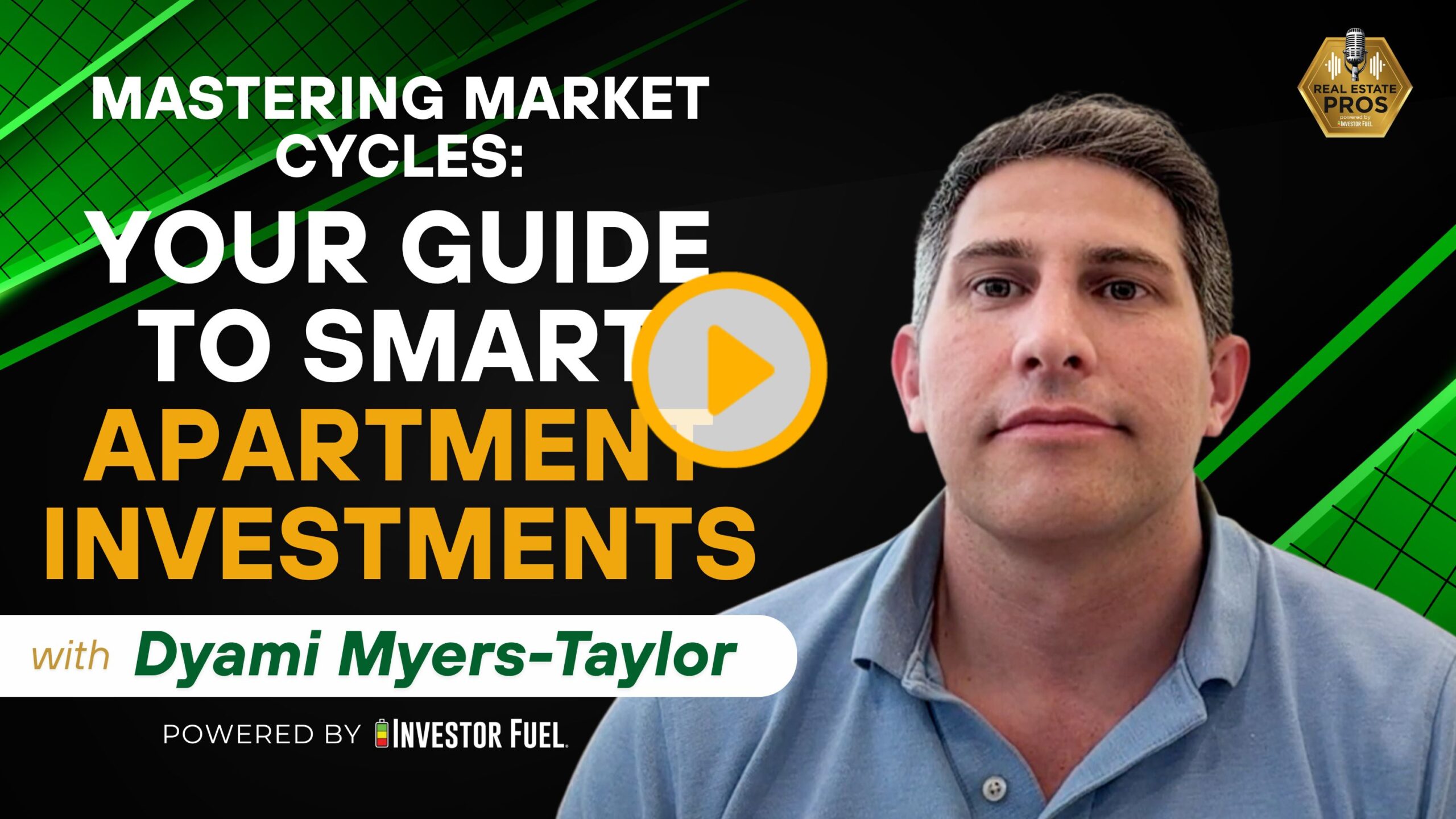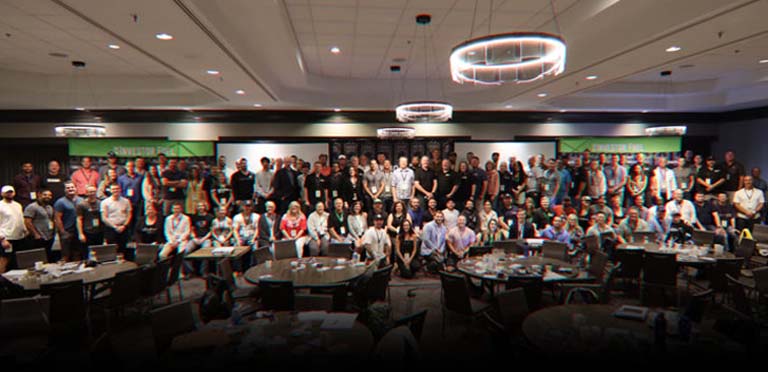
Show Summary
In this conversation, John Harcar and Dyami Myers -Taylor discuss the intricacies of real estate investing, focusing on the importance of due diligence and understanding the market. Dyami shares his personal journey from losing a significant investment to successfully transitioning into apartment investments. The discussion highlights the pros and cons of fix and flips versus apartments, emphasizing the need for thorough research and knowledge in making informed investment decisions.
Resources and Links from this show:
Listen to the Audio Version of this Episode
Investor Fuel Show Transcript:
John Harcar (00:01.962)
All right. Hey guys, welcome back to our show. I’m your host, John Harcar, and I’m here today with Dyami Myers-Taylor. And what we’re going to talk about is, know, not besides his, his journey in real estate and business. We’re going to talk about how to really make sure you know what you’re investing in, right? How to really do due diligence. I really know. Remember guys, that investor fuel, we help real estate investors, service providers, really all real estate entrepreneurs, two to five X their business.
Dyami Myers-Taylor (00:04.462)
So,
John Harcar (00:30.692)
We provide the tools and resources to grow that business you want to grow, which helps live the life that you wanted to live. Diyami, welcome to our show.
Dyami Myers-Taylor (00:40.208)
Thank you, John. Thank you for having me and I look forward to having the conversation.
John Harcar (00:44.896)
Yeah, yeah, me too. That’s awesome. I didn’t know that you were you were once part of investor fuel and that’s cool. And I want to talk more.
Dyami Myers-Taylor (00:49.813)
Yeah, you guys do a great job. Just to give a little plug, I was part of Investor Fuel and it’s a great group of like-minded individuals that are growing their business in the real estate, Fix and Flips. I was part of the apartment. I don’t know if it’s a division, but apartment groups. And so, yeah, they do a great job.
John Harcar (01:07.392)
Mm-hmm.
Awesome, man. Well, thanks for the plug. But, you know, I’m looking forward to talking about, you know, what you mean as far as knowing what to invest in. And before we talk about that, right, tell our audience a little bit about you so we can get to know you kind of about your background, your journey in real estate and what brought you to today.
Dyami Myers-Taylor (01:29.185)
Great. Yeah. So I always we didn’t grow up with like the silver spoon in our mouth type of thing. And there’s times we were homeless. Right. It was it was not the worst, but also not the best. Right. And but I always wanted to have passive income. I always wanted to have financial freedom. And I didn’t really know how to do that. And so when I got out of school,
high school, I went to college and I was doing sales jobs and then after college I got into insurance because I heard about this thing called passive income and I thought, okay, well in insurance that’s how they pitch people, build up a book and you have passive income. And it wasn’t until later that I realized, you know, I became very successful, I was the number two producer out of about 500 plus reps.
and was making good money, six figure plus money back in 2009, 2008, 2009. And so I had this problem because the market had just corrected. Everything was in a free fall and I had cash and I had credit, but I didn’t know how to invest. And I put my money with a buddy who…
the company was growing quickly and I knew nothing about investing in private companies. didn’t know how to evaluate it. It was basically just my friend and I was like, okay, sure. Here’s, you know, and within six months I lost 92 % of my investment and that was a third of my net worth at the time, about 35%. And it woke me up. I was like, I think I need to learn. I can’t take too many of these hits.
John Harcar (02:58.227)
Trust him, right? Yeah, okay, let’s make money.
John Harcar (03:14.539)
Yeah, that would knock something into you. Right.
Dyami Myers-Taylor (03:20.704)
And so it made me start to look and it made me start to really learn. And this whole investment philosophy that Wall Street has laid out for people, I started to question because I was seeing people not necessarily at the time like Nancy Pelosi’s got $100 million that worked on $100,000, $200,000 salary. But I saw people who were doing better than the market.
John Harcar (03:39.72)
Right, right.
Dyami Myers-Taylor (03:48.01)
And the market was doing terrible at the time, 2008, 2009, 2012. And so I started doing my research. started looking at different asset classes. I started looking like, what’s something that I can know? what’s something that I duplicate the efforts? Like 75 % of all, 80 % of all of the stock market trades are all flash trades, meaning you got 10,000 trades in one second. And it’s all done by computers and
John Harcar (03:50.941)
Mm-hmm. Mm-hmm.
Dyami Myers-Taylor (04:17.769)
It’s a very different world. can’t compete against that. I can’t win against that. And so that kind of led me to real estate. And I started learning about multifamily apartments, partly for that passive income. And then I went to go work for bigger companies. So I went to work for companies that were doing that. I had tried to do it a little bit on my own, but didn’t have the knowledge. And so after about nine months, I was like, okay, I need to go get
John Harcar (04:43.381)
Mm-hmm.
Dyami Myers-Taylor (04:46.635)
a job, but I was putting deals together for private equity real estate funds, put together 260 portfolio of single family homes as institutions were starting to move into the, now they call it BTR, built to rent, but before it was like the REO to rental space. so, institutions buying houses. And I went to work for a $250 million fund at the time, Bainbridge.
John Harcar (05:02.635)
Build Terrania.
John Harcar (05:12.075)
Mm-hmm.
Dyami Myers-Taylor (05:14.155)
ended up being basically acquisition analyst for them helping source pref equity for you know large in a multi hundred million dollar deals and stuff like that and started learning the investment game from real professionals and at the time a lot of the people who are had been in the business for ten twenty years i’m taking some licks and their portfolio because two thousand eight two thousand nine two thousand ten
John Harcar (05:40.171)
Dyami Myers-Taylor (05:43.069)
And so it really was a wake up call for me to just say, okay, mental note, when this happens again in 10 years, because there’s a reason it’s called a cycle, I’m gonna remember this. And so I worked for different private equity real estate funds, real estate operators from 2011 till about the end of 2018. Did half a billion or so in multifamily acquisitions, worked on different projects doing
John Harcar (05:48.937)
Hahaha
Dyami Myers-Taylor (06:11.403)
acquisitions component to that, but as a small piece in a bigger company and with no equity and no, you know, I was just a W2 employee. And then so 2018, I decided, you know, it’s, I have a pretty good handle on this. And it’s time for me to make myself wealthy, right? You know, at the time, I was wanting
John Harcar (06:16.298)
Right.
Dyami Myers-Taylor (06:37.82)
wanting more, wanting more freedom and wanting to put some of those skills to use. And so, yeah, I brought my first project. I bought it for 1.85. I sold it for 2.85 18 months later. And we had put in basically 230, 240, something like that in improvements. And so that was my first kind of kicked off my
John Harcar (06:39.669)
Mm-hmm.
John Harcar (06:50.698)
BAH!
John Harcar (06:56.715)
jeez! Nice!
Dyami Myers-Taylor (07:06.997)
as an investor and started my own business. And since then, I’ve done about 40 million or so in transactions and buying. We’ve done a handful of fix and flips, but we’re shifting now to just only focus on apartments. And we have about a 74 unit, 75 unit apartment portfolio in Texas and Florida. And we basically do the buy, fix,
John Harcar (07:15.037)
Awesome.
Dyami Myers-Taylor (07:35.218)
sell or buy fix refinance. Yeah, yeah, exactly. That’s right. And so we like to focus on things that we can control, but also we’re taking a macro view from the investment space to really understand like where we’re at in the cycle, how are things playing out from an interest rate perspective, because that has
John Harcar (07:38.015)
the burr, the burr kind of thing without the last burr, the rent.
Dyami Myers-Taylor (08:03.22)
a huge impact on the valuations for commercial real estate and every other asset class. So, yeah, we spend a lot of money on research. We’re kind of in the early phases. Right now, it’s just me with the business. I’m shifting business models from fix and flips to just departments. And so we just have two flips that we’re doing. other than that, we’re focusing on bigger stuff. yeah.
John Harcar (08:31.051)
Very, very cool.
Let’s go back a little bit. So when you first started getting into this and learning this stuff, why was it important for you to go work for someone to learn it versus just use whatever resources out there we can find to
Dyami Myers-Taylor (08:50.867)
I ran out of money. Yeah, basically. So I went to do it myself. I had lost that money with my friend in the friend’s company, but I still had about a year, year and a half of income. And after nine months, was like, okay, I was learning. So was learning while I’m trying. my account balance is going down every single month.
John Harcar (08:52.297)
Haha.
John Harcar (09:00.0)
Right.
John Harcar (09:19.499)
Mm-hmm.
Dyami Myers-Taylor (09:19.981)
And I’m increasing my knowledge every single month. But the time after about nine months, I made my first revenue from actually wholesaling some of that 260 unit property portfolio. And they cut me out of a quarter million dollar commission and I got paid $26,000. And so I had maybe six months left and my fiance at the time is like,
John Harcar (09:23.966)
every month, right?
John Harcar (09:43.275)
Dyami Myers-Taylor (09:49.905)
you need to get a job. And I didn’t, I wanted to make my future wife happy at the time. so, so I ended up, you know, I had tried to buy fix and flips. I tried to do it, but it was really, I ran out of money in terms of like, and, and I didn’t want to, you know, I wanted to make sure that I can, you know, do everything I needed to do with my, with, with everything, all of my responsibilities and stuff. So.
John Harcar (09:51.371)
Hahaha
John Harcar (09:55.471)
Sure, of course.
John Harcar (10:19.167)
Sure.
Dyami Myers-Taylor (10:19.411)
So yeah, I went to learn. It was good experience. I went to different companies and
Yeah, I think it was a great retrospect. It was was it was great because it provided a different framework. So there’s a lot of people that I’ve met that have entered the syndication based world syndication being pooling people’s money together. Which in the investment world that’s often to fund or it might be an individual offering a private.
Individual syndication just like one property and no one deal versus a fund you have more than one might have five or ten properties in that one fund. But yeah I learned a lot of very sophisticated stuff and at the same time I was still learning what was out there from hey how to fix this sell a house so is this convergence of Main Street and Wall Street and and and seeing what was like.
John Harcar (10:51.846)
So yeah.
John Harcar (11:11.807)
Mm-hmm.
Dyami Myers-Taylor (11:18.291)
some of the stuff that didn’t really work at Main Street and some of the stuff that worked better, I was able to of mend the two because Wall Street is very rigid in terms of a box. Or you can only invest in a city with more than a million people. Where it’s like if you’re a guy in a 250,000 person town, 300,000 person town, you can still find some good opportunities. So kind of
John Harcar (11:30.527)
Right.
John Harcar (11:35.274)
Right.
John Harcar (11:44.793)
for sure.
Dyami Myers-Taylor (11:48.691)
I would say integrating those two philosophies. And then that gave me a decent framework for going out and what we do now.
John Harcar (11:58.278)
Got it. Okay. So what are the pros and cons of apartments versus fixed flips?
Dyami Myers-Taylor (12:05.756)
So fix and flips is great because it generates active income and you can generate a high active income. The last five years we did about, generated about three millions in profit. And then we used a portion of those profits to go buy departments. And so with fix and flips, you can generate high income and high returns on your capital, especially if you are getting a high leverage,
leverage being a loan. And there’s a lot of hard money lenders that will provide fix and flip financing that 90 plus percent loan to cost. And so you can have good returns on capital, but that will change unless you are leveraging your money and going raising your money from other people, right? Because
You’ll need to build a team and then once you have a five person team, you’ve got all this overhead. so it really is a business. It’s not just like, let me just flip the house. You really have to run it like a business. so on the one end, you got high income, high tax. You basically have a job. Until you could grow that business to say a million in profit.
John Harcar (13:14.013)
Sure. Yeah.
Dyami Myers-Taylor (13:29.938)
for a fix and flips, you basically have a job. With apartments, it’s a much longer cycle in terms of it could be three years, it could be five years, it could be seven years. And you have a lot less tax burden because you basically have no taxes. But you have a lot less income on the same dollar. if you got 100 grand, you could do
so many fix and flips a year, you can generate so much money. That’ll be a lot more than if you have a hundred grand and you go buy a rental. But yeah, yeah. And I like apartments because, you know, I had known this, but it really was apparent when I had a project where I spent the same amount of time. It was a project I bought for
John Harcar (14:06.527)
by one apartment building,
Dyami Myers-Taylor (14:28.401)
Basically like $425,000. I put in $126,000. I sold it for $875,000. It was a home run and it took a year and a half. I changed a house into two houses and it was a lot of regulatory problems and all that stuff. And then there was another property that I had that was an apartment and all we did was update the kitchen, the bathroom, like the flooring, new paint, easy cosmetic finish work.
John Harcar (14:36.501)
Yeah.
John Harcar (14:55.029)
Mm-hmm.
Dyami Myers-Taylor (14:58.607)
that doesn’t require getting waiting six months for a city permit. Yeah, especially San Diego County where the ADU laws were available at the state level. And so in theory, you should be able to do an ADU. And then at the city level, they were blocking it and not giving permits. And then so that, I mean, that delays your ability to be able to fix the property. So I basically made the same money
John Harcar (15:02.373)
permits or anything like that.
Dyami Myers-Taylor (15:27.793)
Actually, I made more money, twice as much money on the apartment doing less work than I did on this one project that was a house. And yes, it was a good project, right? But that opened my eyes. And then as I grew my business, about like basically about a year and a half, two years ago, I just looked at 80 % of my time was on the fix and flips. It was generating
John Harcar (15:41.087)
Yeah, yeah.
Dyami Myers-Taylor (15:57.264)
20 % of my profit. The apartments was the exact opposite. It was 20 % of my time and it was generating 80 % of my profit. And so that’s when I decided, okay, you know what? I’m just gonna effectively shut the business down for fix and flips. And I’m just gonna go all in on apartments. And I didn’t necessarily do that cold turkey. It’s kind of been a little bit of a transition.
John Harcar (15:57.74)
20 % of your income. Yeah, yeah.
John Harcar (16:08.799)
Ha
Dyami Myers-Taylor (16:24.624)
winding down the fix and flips down and then ramping up the apartments. so we have a couple of flips left, but we’re moving away from that and just focusing on bigger projects.
John Harcar (16:34.859)
Very cool. What type of struggles or are there any type of like things that are a little bit more difficult when you got into the apartments versus the fixed flips?
Dyami Myers-Taylor (16:44.512)
John Harcar (16:45.803)
any challenges.
Dyami Myers-Taylor (16:47.6)
Well, so if you take any market, San Diego has about 35,000 transactions a year. And roughly in fixed inflips, you have about one to 3 % of the market is gonna be distressed. So that ends up being, say 350 to a thousand houses that potentially are distressed.
And then so whoever the competition is, not all of those distressed deals are going to be profitable, right? So let’s say maybe half of them are profitable and then you might have a couple in San Diego, had a couple that was. Well, my point is you’re looking at deals every day. The volume of transactions is is much higher in terms of the number of sales, the number of opportunities that you look at in apartments.
In 2022, there was something like 104 or 107 apartments over 100 units in size that sold in the entire United States. So you have 50 states and 100 apartments sold. And some of those states you don’t want to be in, like New York, Chicago, some of those cities, Portland, Seattle, like San Francisco.
even L.A. Those are different plays and have different regulatory risks. And so a lot of investors stay away from that. And so if you take those out, you just have much fewer transactions when it comes to apartments. And some of that volume is starting to come back in the last two years. But my point is you’ll have a much higher number of volume of houses to look at.
John Harcar (18:16.747)
Yeah.
John Harcar (18:30.719)
Yeah, that’s true.
Dyami Myers-Taylor (18:44.367)
versus apartments. But apartments will take longer to effectively underwrite. Like you’ll do a back of the napkin for both properties. But the next step, which is a more deeper level of analysis, is much quicker with a house than it is with an apartment. And I mean, when I first started, it would take me a week to really go through all the stuff that you start to do to model it out correctly.
John Harcar (18:48.501)
Right.
John Harcar (19:02.718)
yeah.
Dyami Myers-Taylor (19:11.343)
When I say model it out, I’m talking about a financial model where you have an Excel sheet or a tool that’s a software program and you’re putting in all the inputs and garbage in, garbage out. So if you put in garbage, yeah, so it’s really to do it correctly, you need to make sure that you’re dotting your tees or dotting your I’s, crossing your T’s, making sure that all your inputs are correct because a $10 million building
John Harcar (19:14.976)
Right.
John Harcar (19:23.691)
You’re gonna get out garbage,
Dyami Myers-Taylor (19:38.939)
That’s a ten million dollars mistake. yeah, you know, so it’s much, much more difficult. So, yeah, so just takes a little bit longer.
John Harcar (19:41.131)
It’s a big mistake.
John Harcar (19:50.572)
Let’s talk a little bit about what our kind of topic was, you how to make sure you know what you’re investing in, you know, touch, tell us a little bit about that. Talk to us about that for the next couple of minutes.
Dyami Myers-Taylor (20:01.078)
Yeah. So what was important for me is to really invest in something that I can know. And where did I get that? Buffett. Right. He talks about your circle of competence, your moat. And I didn’t want to go learn, you know, day trading. I didn’t want to. But I also knew that like and there’s a lot of
different information out there for different demographics. like what ultra high net worth individuals invest in, somebody worth 30 million or more, right, in investable assets. And what, you know, Dave Ramsey is promoting are completely, completely different worlds. And if you actually just look at like what the data says,
John Harcar (20:50.912)
Right.
Dyami Myers-Taylor (20:55.95)
As you’re moving up in your demographic, you have to get different data. And at some point, you know, you’ll look at any person’s built substantial wealth didn’t do it by diversifying across everything. Now, after they built their wealth, then as a stored value, then they diversified. But in terms of building the wealth, they did concentrate. And Buffett talks about this. He’s like,
John Harcar (21:15.701)
Then.
Dyami Myers-Taylor (21:23.97)
you know, if you can basically buy the best two, three, four buys businesses in town, what do you care about all the other ones? Like, and so what I, what I thought about was, okay, well, what, can I learn? What’s knowable and what do I want to know? And so that, that led me to real estate. And I think also, you know, I’m not doing corporate derivatives. This is ones and twos, right? This is very like,
John Harcar (21:47.787)
Mmm.
Dyami Myers-Taylor (21:52.773)
okay, you got to divide and subtract and so on. But this is fourth grade math. Occasionally, maybe you have like entry level algebra, you know, that type of thing. Like, okay, what should the rent be? But really, it’s a very simple, it’s simple, but it’s not easy. And it’s simple to understand because there’s legal, there’s financial, and there’s physical due diligence on any property.
And so when you have those three components, you can break down, for example, your physical components down to the useful life remaining of every single component of the structure. So you have a roof. Any property is basically four walls. It’s a box, basically. You’ve got your roof, you’ve got your structure, your foundation, and then your mechanicals, which is plumbing, electric, HVAC, that kind of stuff. And those are all your big ticket items. And so
If you make sure that you’re good with those items, that’s a huge part of your physical due diligence. Your financial due diligence, when you’re looking at operating statements for apartments,
My best advice would be to go look at 100 of them, right? So that you get a good sense because different brokers, some are better than others, some are more truthful than others. And if you’re gonna do your first deal, you need to have a bigger data set so that you can know what you’ll likely have. And also you can…
John Harcar (23:10.219)
He
Dyami Myers-Taylor (23:30.848)
There’s benchmarks for multifamily commercial real estate. CoStar has a lot of them. CoStar is a software provider. so my point is it’s not unknowable. Like you can call an attorney to handle your legal risk and talk to the title and have an attorney read the survey, pull a survey, the title document, see what kind of title insurance that you’re getting and talk to somebody about it.
John Harcar (23:59.956)
Right.
Dyami Myers-Taylor (24:00.573)
It’s not that, it’s not terribly complicated. It’s not necessarily simple, it’s simple, but it’s not necessarily easy. There’s a lot of things you gotta do to put together, but it’s something that you can learn, it’s something that you can know. And I’m happy to give my due diligence checklist for multifamily real estate for people that are listening, if you want it. Reach out to John, I’m not quite sure how to promote it, but.
John Harcar (24:27.627)
Well, no, yeah, no, what? Yeah. And I was going to say, you know, we’ll put, yeah, we’ll put all, we’ll put all the stuff. If you want, if you haven’t sent me that link, send it to me. We’ll put it in the show notes. We’re getting close to running out of time here, but I want to say, Hey man, thank you for coming on and sharing all this. It’s really, really good info. We’ll put it all your info, the show notes, your phone number, your emails, your socials, whatever you sent to us. And guys reach out, man. If you have any questions, you have any interest in.
Dyami Myers-Taylor (24:31.496)
Yeah, we can provide it to him.
Dyami Myers-Taylor (24:37.237)
Sure.
Okay, cool.
Dyami Myers-Taylor (24:44.896)
Yeah.
John Harcar (24:57.228)
maybe getting into apartments or some of the stuff he said resonated with you, reach out and take advantage of his knowledge. And I hope you guys enjoyed the show as much as I did. Thank you again, Dyami, and guys, we’ll see you on the next one. Cheers.
Dyami Myers-Taylor (25:11.812)
Thanks, John.







